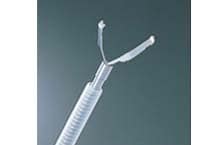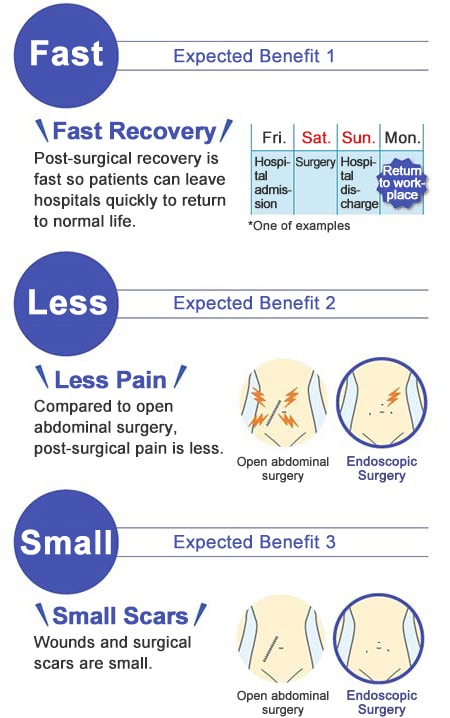Minimally Invasive TherapyTreatment Tool and Endoscopic Surgery
Treatment with Endoscopes
Endoscopes are used not only for observing internal organs but also to conduct various procedures, including the removal of suspicious lesions detected in pathological examinations, extracting accidentally ingested foreign objects, and removing polyps. Compared to open abdominal surgery, treatments performed through minimally invasive therapy help to reduce patient burdens.

Structure of Endoscope Tip
Nozzle
Ejects water or air to make observation of internal organs clearer
Light-guide Lens
Illuminates internal organs
Forceps Outlet
Sucks liquid, or opens for forceps used for tissue collection and other procedures
Forceps
Instrument for procedures
Objective Lens
Takes images of internal organs
Various instruments are used in conjunction with endoscopes to perform therapeutic procedures.

Biopsy Forceps for extracting foreign objects

Hemostasis Clip to inhibit bleeding

Stone Retrieval Basket for breaking up and removing stones

Electrosurgical Snare for removing polyps
Endoscopic Surgery
In endoscopic surgery, multiple small openings are made on the abdomen to insert endoscopes and take images for display on a monitor. Various instruments are inserted through openings to perform procedures while the surgeon views a monitor.
Endoscopic surgery does not require large abdominal incisions, so unlike conventional open abdominal surgery, it is expected that patients feel relatively little post-surgical pain, realize reduced hospitalization time and return to normal life quicker. In Japan, endoscopic surgery gained popularity in the 1990s starting with gallbladder removal surgery, and today the scope of application also includes highly complex surgeries such as large intestine surgery and kidney removal.
The latest surgical endoscope systems feature technologies such as 3D imaging for depth perception and 4K imaging for extremely high resolution. Olympus continues to move forward with the development of such technologies in support of increasingly advanced surgery.


Gastrectomy using surgical endoscopy system

